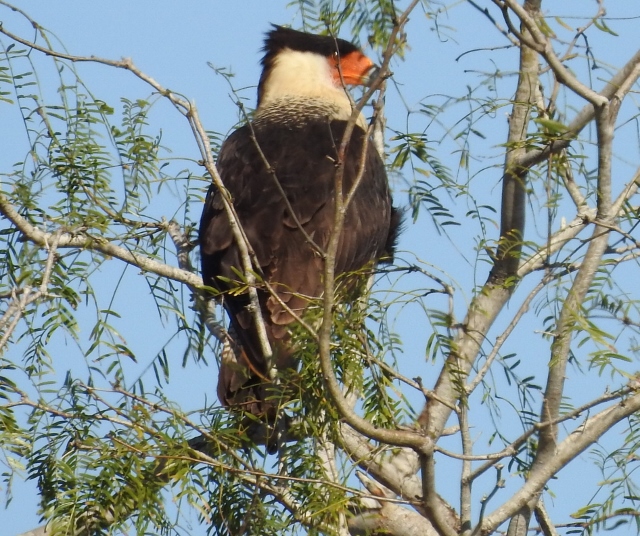
With its sky-blue bill and facial skin reminiscent of candy corn, I instantly recognize this handsome, flat-heated, black-capped fellow—even as I zip down Highway 281 at 75 mph. The bird has an unmistakable silhouette.
A slender raptor, the crested caracara (Caracara cheriway) has a large, black-crested head, orangish facial skin, white cheeks and neck, a light, black-studded chest, long yellow legs and a hooked blue bill. Males and females look much the same, but juveniles sport brown feathers and may have red, gray or pinkish facial skin and grayish legs.
A gracefully circling caracara, with its dark feathers, resembles a black vulture, but the caracara has a white undertail and outer flight feathers, as well as a black-barred tail. Also, more so than vultures, caracaras flap their wings with strong, steady beats, with wingtips pointing down. Caracaras usually fly close to the ground, and they walk as effectively as they fly.
The crested caracara, sometimes called the Mexican eagle, may, in fact, be the “eagle” on the original Aztec codex holding a snake in its talons, though a golden eagle adorns the Mexican flag. Though in the falcon family, Falconidae, the caracara looks and behaves rather like a vulture. A caracara, which also dines on carrion, has the weak talons of a vulture—claws ill-suited for carrying prey.
Its inclusion with falcons—speedy, streamlined, birds with pointed wings and long tails—appears to be based on the caracara’s structure, not its habits. In fact, some think it more rightly fits into the vulture family, Cathartidae. Older birding guides may call it Caracara plancus, as it was previously conspecific with that bird, the southern caracara. The caracara’s name likely stems from its rattling, guttural call.
Supreme generalists, caracaras eat anything from insects to decaying cows. They consume lizards, snakes, frogs, birds, eggs, fish, insects, rabbits, skunks, armadillos, mice, squirrels and javelinas.
From up high, a caracara or two—they sometimes hunt in pairs—scans the ground, actively hunting or scavenging prey in early mornings or late afternoon. In constant motion, it preens, watches, swivels and repositions itself. Eyeing its victim, the bird sweeps low, lands and often runs after prey on foot, chasing jackrabbits or roadrunners through mesquite scrub. Caracaras also wade in shallows to snag fish.
At dawn, caracaras search for roadkill along highways. Also, they approach fires, like those set before sugarcane harvests, seizing victims. Naturalist Gus Rentfro, of Rio Bravo Reptiles, said he sees hundreds of caracaras at “sugarcane harvesting sites where they search for carrion or try to steal other birds’ carrion.” Caracaras follow plows and tractors, scouring the soil for exposed invertebrates and rodents. With its foot, the bird lifts branches and cow dung to uncover prey, sometimes eating turtle eggs or digging up insects. A caracara also harasses vultures and pelicans until they disgorge their feasts.
Caracaras typically dominate over the vultures with whom they gather to devour a carcass, occasionally chasing them off. Recently, I noticed a caracara posed among the turkey vultures on a pile of dead mesquite branches at Laguna Atascosa, with another walking beneath.
A caracara usually remains quiet unless agitated. Then, throwing its head back, snapping it forward and sometimes rolling it across its shoulders, it emits a rattling, sometimes multisyllabic “grrrk” or “wuck”.
Crested caracaras are nonmigratory but may wander; young vagrants have strayed as far north as Canada, perhaps due to drought, habitat changes or population dynamics. They thrive in pastures and ranchland, deserts, savannas, scrub and river edges from Mexico into mainly southern Texas, central Florida, and southern Arizona.
Caracaras breed here from January through September. During courtship, the birds toss their heads back, making guttural cackles, and they preen one another. Most are monogamous.
The birds build nests from about 12 to 30 feet up in a tree, cactus, palm or artificial structure offering good visibility. Males and females build layered, bulky but well-constructed nests consisting of substances like vines, hair, dung, weed stalks, cotton, grass, Spanish moss and twigs. Caracaras may build atop their own or other birds’ previously used nests, adding materials.
The female lays from one to four white, pinkish or buff-colored, irregularly-blotched eggs right away, or she may await a more opportune time. Both parents incubate the eggs, which hatch in from 30 to 33 days. Most caracaras have one clutch a year. Only 30% of second clutches are successful.
Young birds, who scream hoarsely for food, fledge at from seven to eight weeks. They remain near parents, who may feed them for a few months, possibly as many as ten. Also, immature birds from several clutches may join up. Sociable birds, caracaras may live in groups of as many as thirty, a mixture of juveniles and adults.
Caracara populations declined in the twentieth century, especially the isolated groups in Florida, mainly due to habitat loss from urbanization and agricultural development. Evidently, some people, succumbing to an unreasonable aversion to scavengers, have even shot and poisoned caracaras. Both Florida and the federal government classified the state’s caracaras as “threatened” in 1987, a status currently maintained.
Caracaras, however, appear to be increasing in Texas and Arizona. In fact, the International Union for Conservation of Nature (IUCN) lists them as of least concern (LC).
With their varied diet and ability to thrive in dry places, caracaras do not face such dire predictions from climate change as do many birds.
As we humans make our sometimes careless, clumsy way on this planet, caracaras—like similarly adaptable crows, grackles and raccoons—may benefit from some of our more unpleasant or even destructive habits, like providing scraps for tasty rodents and running down animals with our cars. Caracaras are protected by tje Endangered Species Act and the Migratory Bird Treaty Act—both of whose regulations are under current revision.